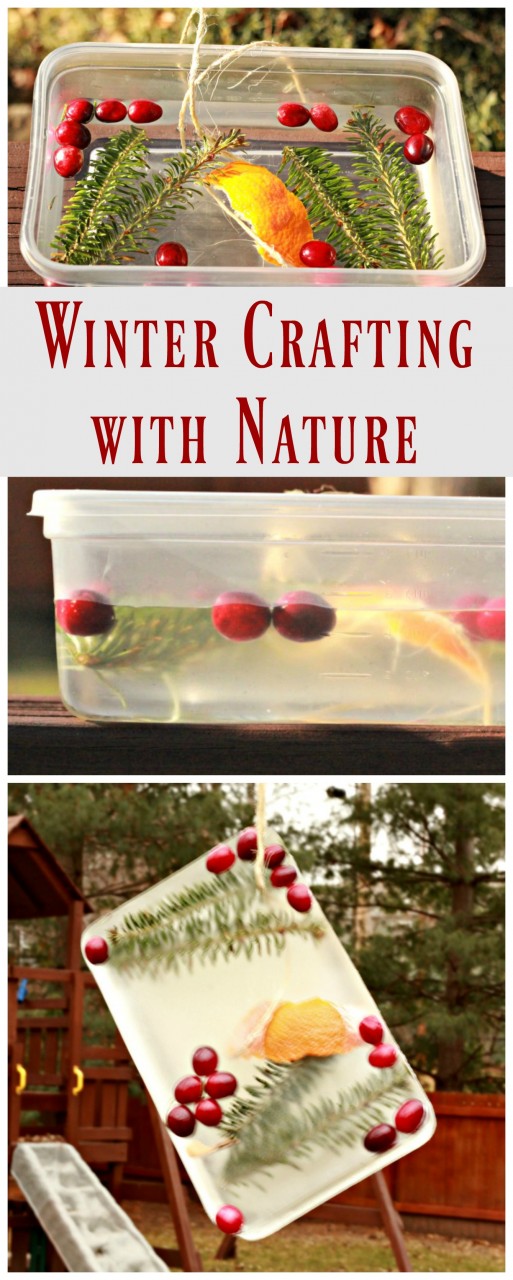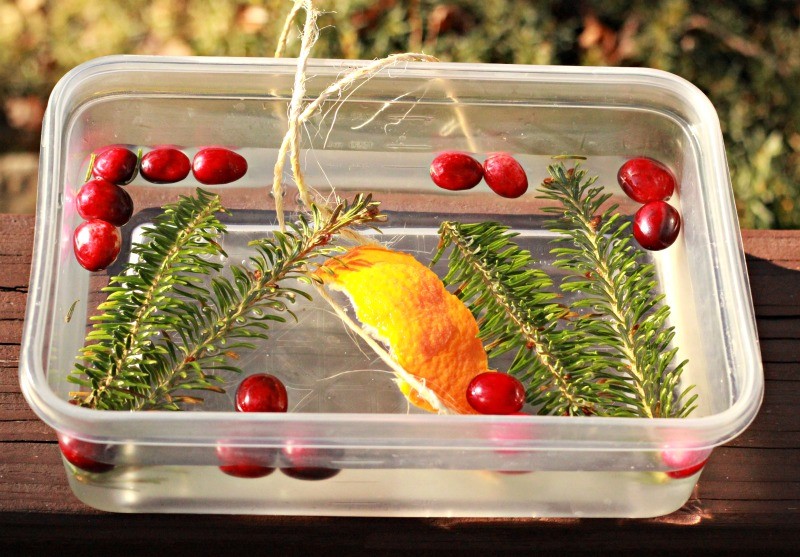Enjoy this easy Winter craft that combines science, nature & art — perfect for kids of all ages!
I’ll be the first to admit that once Winter sets in, looking for ways to incorpation nature into our day becomes more of a challenge.
There’s always that excitement for the first snow fall when we can head out and explore for animal tracks or make a snowman but everything is so bare and mostly colorless at this time of the year.
That is, unless you take nature into your own hands, add in a little science and create a colorful craft for your window (which is exactly what we did when the temperature dipped last week)!

Winter Craft & Science: Nature Art with Ice
I love this craft idea for cold days! All you need is water and a few colorful items (tree branches, small pieces of fruit, an orange peel) to make a winter ice sculpture that you can hang outside your window.
And the big bonus — there’s even some science involved 😉

First up — gather your supplies!
You’ll need the following items:
- a plastic bowl or container (note: depending on the temperature, this could crack during the process so either use one you don’t care about recycling or choose a thick/sturdy plastic)
- a variety of natural items: pine branches, cranberries, orange peel, cinnamon sticks, birdseed, leaves if you still have some around the yard (be sure the items you use are safe for birds)
- water
- a day when it will be below freezing outside and
- a piece of twine which you’ll use to hang the sculpture once it’s frozen.
Plus it’s always a good idea to read a book (or two!) with projects like these — here are a few we’d suggest along with affiliate links so you can learn more about each one:
Water Can Be . . . shares all the forms water can take — a pond, snow, rain. This is a great introduction for young kids to the idea that items can take different forms.
What Is the World Made Of?: All About Solids, Liquids, and Gases is one of the key points of this experiment — the discussion of matter and how it can take different forms such as a liquid or solid. Great for elementary kids who ask a lot of questions 😉
And Wonderful Winter: All Kinds of Winter Facts and Fun shares a lot of great details about winter including how ice forms, why it snows and the science behind snowflake shapes!

Creating Ice Sculptures & Nature Art
Fill your container about 2/3 full of water. If you have a very deep container, you may only need it half full. Remember, ice will be heavy so choose a more shallow bowl if you have one.
Have your kids choose their items and arrange them the way they would like — this is part of the design process.
Shhh… don’t let them know that their design might change …

Once you have the design, bring the bowl outside when temperature is below freezing (32 degrees Fahrenheit or 0 degrees Celsuis) — bonus: math lesson on temperature right there!

If you look at your container from the side, you’ll see some items float and others will sink to the bottom. Like our Will it Float or Sink experiment, this is a lesson in physics — specficially the density of an item in relation to water.
Have your kids predict what might happen once things begin to freeze.
Young kids especially like this exeriment so grab the free printable Will it Sink or Float? printable and use it during your project.
The Science of Frozen Water
Now the first thing your kids will ask is “How long will it take to freeze?”
Well, that depends on how cold it’s going to be at your house 🙂
The time it takes water to freeze depends on the temperature of the water when it starts along with the temperature outside + the amount of water you have in your container.
So basically, there’s no easy answer for this BUT you can read more about water freezing at this great explanation from the Physics Department at the University of Illinois.
We decided to leave ours overnight since it’s easier to wait while you’re sleeping 🙂
If you’re doing the experiment during the day, you may want to visit our 30 Free Printable Games & Activities list to give you a few things to pass the time.

Once it freezes, you’ll notice a few things may have happened —
1. Some of your nature items have moved!
2. You can no longer see through the water in the container.
Let’s take a closer look at each of these because there’s science involved in both.

Here’s a shot of our containers before and after the water froze. You’ll notice that some of our cranberries, the twine and the orange peel have shifted to different positions.
Was there a rogue squirrel who decided to alter our artwork?!
Nope — the water moved things around when it froze.
Explain to your kids that water doesn’t all freeze at the same time. More than likely, the water at the edge of our container began to harden into ice before the water in the middle. As the water changes temperature, the molecules in the water change too — water is changing it’s physical state from a liquid to a solid. As this happens, the formation of the ice may cause the nature items to shift or move around your container.
So no worries about backyard animals — just the normal freezing process.
On to our second observation — you can no longer see through the container!
Yep, typically drinking water in our country is clear and you are able to see though the water (we would call it transparent). However, ice is more translucent or opaque — meaning light is able to pass through it but you aren’t able to see objects on the other side. This is usually due to the fact that there are impurities in the water and/or small bubbles that form during the freezing process which cause the ice to look cloudy.

Once our nature art was frozen, we could use the twine to hang it outside our window –ours slipped right out of the container but if yours feels like it’s stuck, just run a little warm water around the outside and it will pop right out!
And what do you know! We hung it up that day and it snowed overnight!
Maybe there’s some magicaly winter powers in it too 😉
More Winter Activities
How Do Animals Prepare for Winter?
29 Ways to Have Fun with Your Kids this Winter



